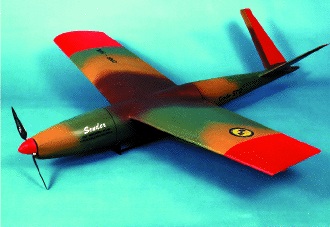Naval Research Lab Sender
The Sender (Self-Navigating Drone, Expendable/Recoverable) multi-purpose mini-UAV was developed and tested by the Naval Research Laboratory between 1992 and 1997.
Sender could be launched either by a bungee cord, a catapult, a booster rocket or from an aircraft. Powered by an electric motor, it could cruise at 93 km/h (57 mph) for up to two hours and was recovered by a belly skid landing. Operational range was 93 km (50 nm) and normal operational altitude was about 300 m (1000 ft). The UAV was equipped with a GPS navigation system, and waypoints could be preprogrammed and updated in flight using a hand-held computer. The UAV could be quickly dismantled and reassembled, and the whole system was completely man-portable.
 |
| Photo: Institute for National Strategic Studies |
| Sender |
At least 20 Sender UAVs were built and used to demonstrate a variety of different payloads weighing up to 1.1 kg (2.5 lb). These included a daylight CCD TV camera, a chemical/biological agent sampler and a tactical jammer.
Specifications
Data for Sender:
| Length | 1.2 m (4 ft) |
| Wingspan | 1.2 m (4 ft) |
| Height | 30 cm (12 in) |
| Weight | 4.5 kg (10 lb) |
| Speed | max: 167 km/h (103 mph); cruise: 93 km/h (57 mph) |
| Ceiling | 1640 m (5000 ft) |
| Range | 93 km (50 nm) |
| Endurance | 2 h |
| Propulsion | Aveox electric motor; 300 W |
Main Sources
[1] Kenneth Munson (ed.): "Jane's Unmanned Aerial Vehicles and Targets, Issue 15", Jane's, 2000
Back to Directory of U.S. Military Rockets and Missiles, Appendix 4
Last Updated: 17 May 2004